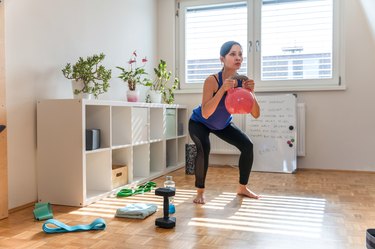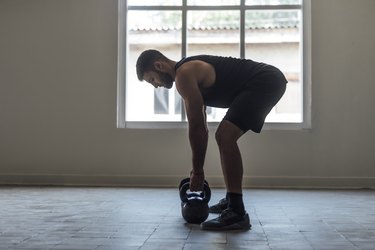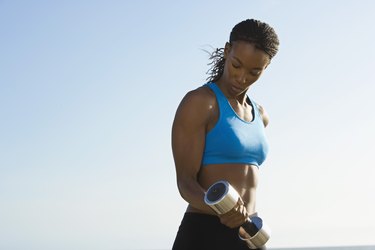
The power of compound exercises is that they combine two movements and work several muscle groups into one perfect flow. Think squat to shoulder press and lateral lunge to biceps curl. But one highly underrated compound move to add to the list? The kettlebell goblet squat curl.
The goblet hold enlists your core to keep your body upright, while the squat to curl allows you to stretch your hips and strengthen your biceps. Sam Becourtney, DPT, CSCS, a New York-based physical therapist, breaks down how to perfect this combo move below. Then, learn more reasons why we're obsessed with this total-body exercise and common mistakes to avoid.
Video of the Day
How to Do the Kettlebell Goblet Squat Curl With Perfect Form
- Stand with your feet hip-distance apart and hold a kettlebell with both hands on either side of the horn, keeping the weight at chest height and tucking the elbows into ribs.
- Shoot your hips back and bend the knees lowering into a deep squat.
- Maintaining your grip on the kettlebell and elbows pressing against your knees, move the kettlebell away from your chest toward the ground.
- Curl the weight back to chest height.
- Press into your heels and push the hips forward to return to standing.
Tip
For those who don't have the hip mobility or core strength to hold a squat while doing a biceps curl, adding a low chair or box to your squat is a great modification. Instead of holding the squat, sit down on the chair and then perform the curl. This helps you target the same muscle groups with extra support.
Warning
Anyone with a history of lower back, hip or biceps pain or injury should avoid this exercise, Becourtney says.
3 Kettlebell Goblet Squat Curl Benefits
Just like any compound exercise, the kettlebell goblet squat curl increases your total-body strength gain and overall calorie burn. But here are some unique reasons this move is so stellar:
1. It Enhances Your Quad Strength
But what stands out about this exercise is that it puts emphasis on the quads, thanks to the squat portion of the movement, Becourtney says.
That's because holding the weight in front of your body when you squat targets the front of your legs, as opposed to your glutes and hamstrings when the weight is behind you.
2. It Builds Up Your Core
The goblet hold also helps build core strength and stability, especially as you curl the weight toward and away from you. Your core has to work hard to keep your upper body stable and rooted in place, Becourtney adds. To help you stay injury-free, you can translate this exercise to daily life when moving and lifting heavy objects.
3. It Stretches Your Hips
The deep squat in this exercise is great for opening up the lower body. "[This move is excellent for] someone with tight hips looking for a way to open them out without spending excessive time on isolated hip mobility exercises," Becourtney says.
Your hips are made up of a group of muscles (hip flexors) that sit across the front of your pelvic bones. These muscles are often tight and stiff, thanks to daily activities like sitting at a desk or driving in a car. But sitting in a low squat and pressing your elbows against your knees provides great stretch for your hip flexors to counteract these negative effects, according to Becourtney.
4. It Isolates Your Biceps
The biceps curl in this exercise might feel more challenging because you don't have the same base of support as you do when standing. By pressing your elbows against your knees, you're really putting the demand on your biceps.
2 Common Mistakes to Avoid
Although the goblet squat curl offers some undeniable total-body benefits, using improper form can make this move less effective, or worse, cause an injury.
1. Hunching the Upper Back
When you pick up a weight that's too heavy, your upper back and shoulders might begin to hunch up into your ears. This puts your neck in an uncomfortable and compromised position, Becourtney says. You don't want your neck straining to move the kettlebell.
Fix It
Use a lighter weight and focus on keeping your shoulders down and back and away from the ears, he says. Also, concentrate on keeping your chest up and out.
2. Swinging Your Curls
Whether you're doing a standing or squatted curl, you want to avoid swinging your arms, according to Becourtney. When you use the momentum from your arms, you take away a lot of the bicep-building benefit of the exercise.
Fix It
Grab a lighter kettlebell and control the weight as best as possible. Keep your elbows locked in place to help avoid swinging the kettlebell, he says.
3 Kettlebell Goblet Squat Curl Progressions
Once you've nailed down this compound move, here are a few ways to challenge yourself.
1. Slow Things Down
Slowing down the lowering (eccentric) phase of the exercise keeps your muscles working longer and harder, increasing your overall strength gain, Becourtney says. Lower into your squat for a four-second count, keeping the pace as controlled as possible.
2. Add a Chest Press
Adding a chest press to this exercise helps you target your shoulders and chest — plus, it makes your core work even harder, according to Becourtney. As you stand back up from your squat, press the kettlebell away from your chest, parallel to the ground. Then, bring it back to chest height before you drop into your next squat.
3. Keep Your Elbows Off Your Knees
During the curl, push your knees out a tiny bit more and take your elbows off your legs for a core burner, Becourtney says. Without the support of your thighs, your arms rely on your core strength to curl the kettlebell toward and away from the body.

